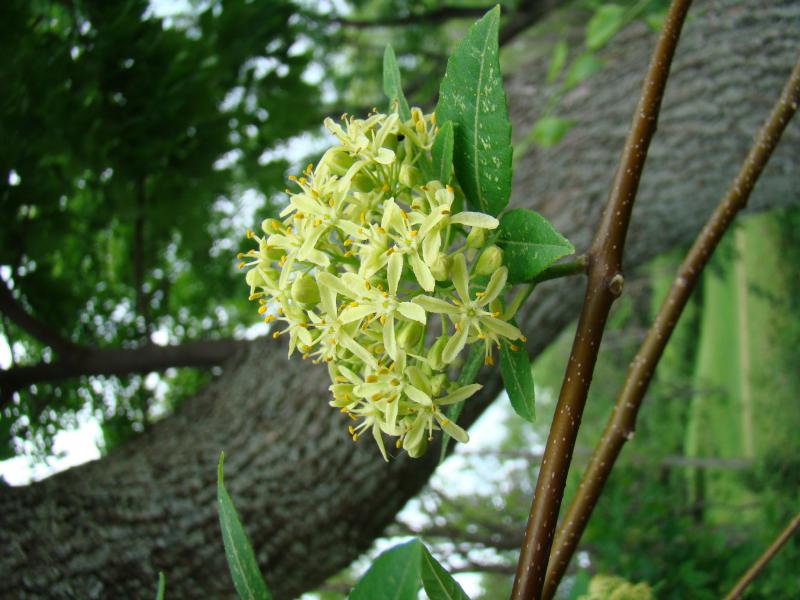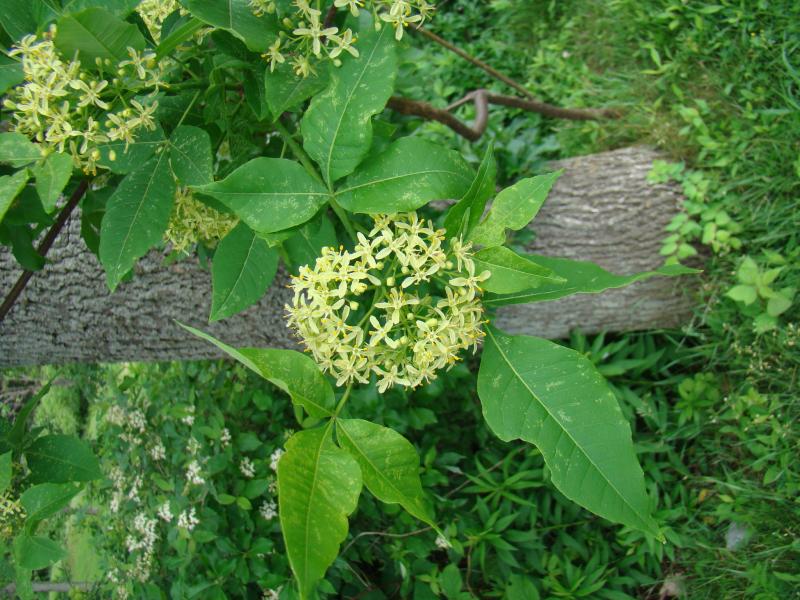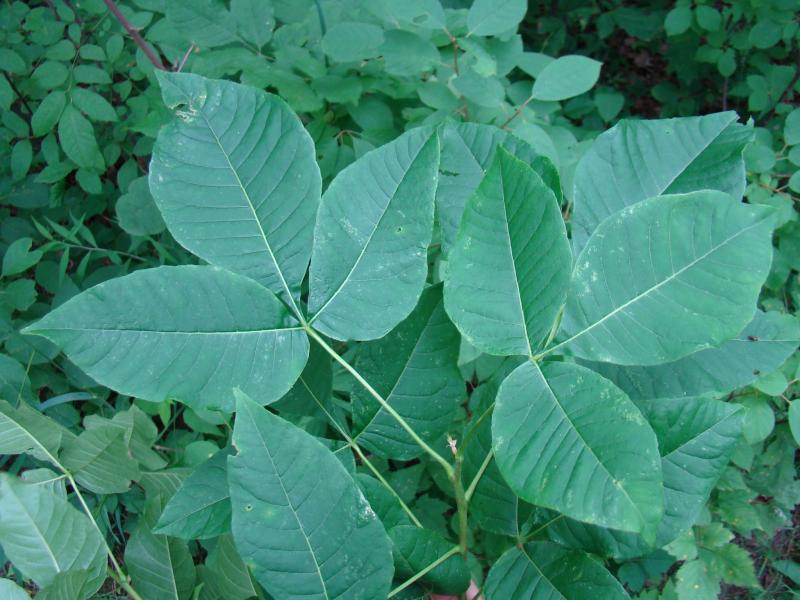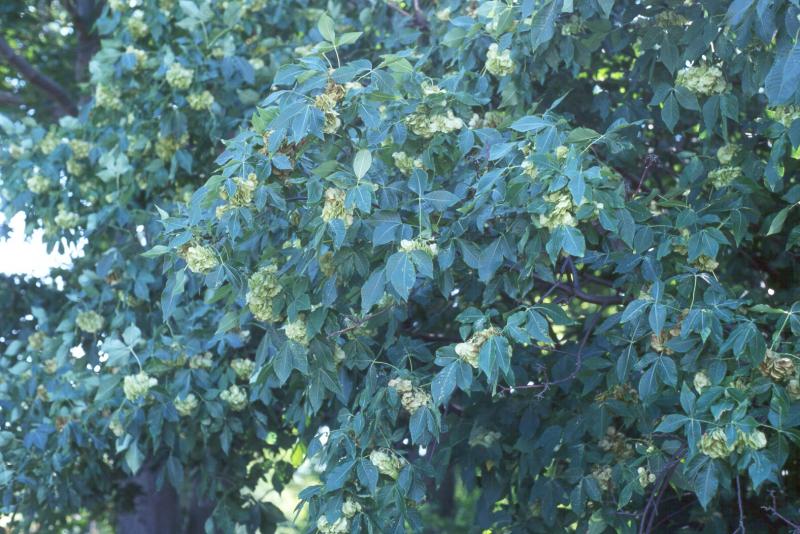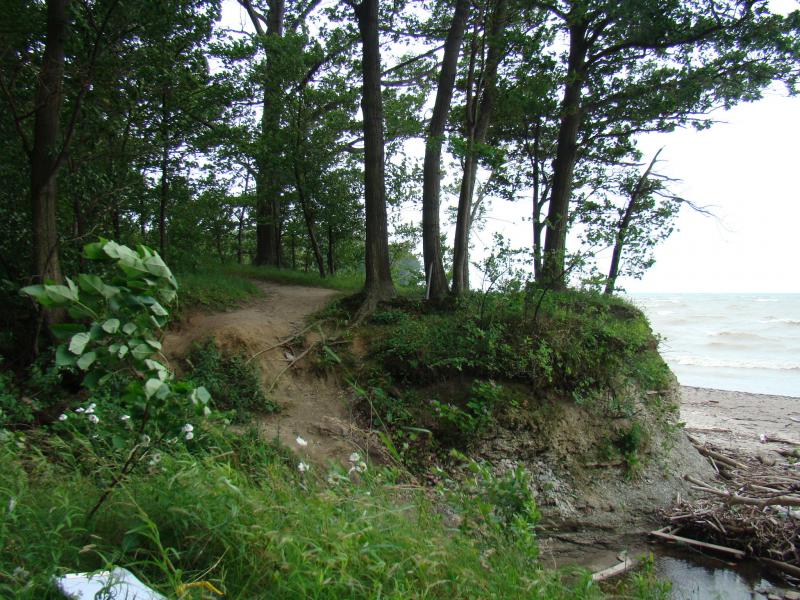Wafer-ash
Ptelea trifoliata ssp. trifoliata None
- Class
- Dicotyledoneae (Dicots)
- Family
- Rutaceae (Rue Family)
- State Protection
- Endangered
Listed as Endangered by New York State: in imminent danger of extirpation in New York. For animals, taking, importation, transportation, or possession is prohibited, except under license or permit. For plants, removal or damage without the consent of the landowner is prohibited.
- Federal Protection
- Not Listed
- State Conservation Status Rank
- S1S2
Critically Imperiled or Imperiled in New York - Especially or very vulnerable to disappearing from New York due to rarity or other factors; typically 20 or fewer populations or locations in New York, very few individuals, very restricted range, few remaining acres (or miles of stream), and/or steep declines. More information is needed to assign either S1 or S2.
- Global Conservation Status Rank
- G5T5
Secure globally - Both the species as a whole and the subspecies/variety are common in the world; widespread and abundant (but may be rare in some parts of its range).
Summary
Did you know?
Wafer-ash belongs to the citrus family whose species grow mostly in the tropics or temperate regions in the southern hemisphere. For native plants in this family in North America, only the prickly ash, Zanthoxylum americanum, occurs farther north than wafer-ash. The winged fruit of wafer ash is unusual for the family (Heywood 1978).
State Ranking Justification
There are eight existing populations but only one has more than 100 plants. There are eight historical occurrences known from 1830 to the 1920s with one from 1943. Cultivated populations occur in eastern New York and Long Island but only central and western New York plants are native.
Short-term Trends
Most populations have been censused only once so population trends are unclear.
Long-term Trends
There are about the same number of historical collections as known extant populations, suggesting the long-term population trend is stable.
Conservation and Management
Threats
Landscaping activities and clearing of vegetation, invasive species, and deer overbrowsing are threats to these plants as well as the development of the Lake Erie shoreline.
Conservation Strategies and Management Practices
Make sure maintenance personnel are aware of these plants when landscaping and maintenance activities take place. Suppress invasive species around plants and reduce deer populations to avoid overbrowsing.
Research Needs
There are no research needs at this time.
Habitat
Habitat
The native New York state populations of Wafer-ash are found in a variety of habitats near Lake Erie, including cobble shores and sand beaches, rich forests and northern hardwood forests (often at the edges or in weedy thickets), and the edges of bluffs and cliffs (New York Natural Heritage Program 2013). Roadsides, forest fragments and borders, waste areas (Haines and Vining 1998). Moist or rich woods and thickets (Gleason and Cronquist 1991). Wooded to more or less open dunes; sandy fields and knolls; fencerows and dry bluffs or banks; rarely in swampy places (Voss 1985). Alluvial thickets, rocky slopes and gravels (Fernald 1950).
Associated Ecological Communities
- Cobble shore
(guide)
A community that occurs on the well-drained cobble shores of lakes and streams. These shores are usually associated with high-energy waters (such as high-gradient streams), and they are likely to be scoured by floods or winter ice floes.
- Great Lakes bluff
(guide)
A sparsely vegetated community that occurs on vertical exposures of unconsolidated material, such as small stone, gravel, sand, and clay, that is exposed to Great Lakes erosional forces, such as water, ice, or wind.
- Great Lakes dunes
(guide)
A community dominated by grasses and shrubs that occurs on active and stabilized sand dunes along the shores of the Great Lakes. Unstable dunes are sparsely vegetated, whereas the vegetation of stable dunes is more dense, and can eventually become forested.
- Maple-basswood rich mesic forest*
(guide)
A species rich hardwood forest that typically occurs on well-drained, moist soils of circumneutral pH. Rich herbs are predominant in the ground layer and are usually correlated with calcareous bedrock, although bedrock does not have to be exposed. The dominant trees are sugar maple, basswood, and white ash.
- Railroad
A permanent road having a line of steel rails fixed to wood ties and laid on a gravel roadbed that provides a track for cars or equipment drawn by locomotives or propelled by self-contained motors. There may be sparse vegetation rooted in the gravel substrate. The railroad right of way may be maintained by mowing or herbicide spraying.
- Sand beach
A sparsely vegetated community that occurs on unstable sandy shores of large freshwater lakes, where the shore is formed and continually modified by wave action and wind erosion. Characteristic species that are usually present at very low percent cover include various grasses and other herbs.
- Successional northern hardwoods
A hardwood or mixed forest that occurs on sites that have been cleared or otherwise disturbed. Canopy trees are usually relatively young in age (25-50 years old) and signs of earlier forest disturbance are often evident. Characteristic trees and shrubs include any of the following: quaking aspen, big-tooth aspen, balsam poplar, paper birch, gray birch, pin cherry, black cherry, red maple, and white pine.
* probable association but not confirmed.
Associated Species
- Acer saccharum (sugar maple)
- Apocynum androsaemifolium (spreading dogbane)
- Aralia nudicaulis (wild sarsaparilla)
- Astragalus canadensis
- Carex tenera (early narrow-leaved sedge)
- Carpinus caroliniana
- Carya ovata
- Circaea lutetiana ssp. canadensis
- Cornus alternifolia (pagoda dogwood, alternate-leaved dogwood)
- Cornus drummondii (rough-leaved dogwood)
- Cornus racemosa (gray dogwood, red-panicled dogwood)
- Cornus rugosa (round-leaved dogwood)
- Coronilla varia
- Dasiphora fruticosa (shrubby-cinquefoil)
- Eurybia macrophylla (large-leaved-aster)
- Fraxinus americana (white ash)
- Hamamelis virginiana (witch-hazel)
- Impatiens capensis (spotted jewelweed, spotted touch-me-not)
- Juglans nigra (black walnut)
- Juniperus communis
- Lindera benzoin (spicebush)
- Liriodendron tulipifera (tulip tree, tulip poplar, yellow poplar)
- Maianthemum canadense (Canada mayflower)
- Maianthemum racemosum
- Matteuccia struthiopteris
- Onoclea sensibilis (sensitive fern)
- Ostrya virginiana (hop hornbeam, ironwood)
- Podophyllum peltatum (may-apple)
- Polygonatum pubescens (hairy Solomon's-seal)
- Populus tremuloides (trembling aspen, quaking aspen)
- Prunus serotina
- Prunus virginiana
- Quercus rubra (northern red oak)
- Quercus velutina (black oak)
- Rhus typhina (stag-horn sumac)
- Robinia pseudoacacia (black locust)
- Salix interior (sandbar willow)
- Sanicula marilandica (Maryland sanicle, Maryland snakeroot)
- Smilax herbacea (common carrion-flower)
- Symphyotrichum cordifolium (heart-leaved-aster)
- Taenidia integerrima (yellow pimpernel)
- Thalictrum dioicum (early meadow-rue)
- Tilia americana
- Toxicodendron radicans
- Viburnum dentatum var. lucidum (smooth arrowwood)
- Vitis riparia (river grape, frost grape)
- Zizia aurea (common golden Alexanders)
Range
New York State Distribution
All the native populations of Wafer-ash in New York are from the shores of Lake Erie or nearby inland locations in Erie, Cattaraugus, and Chautauqua counties.
Global Distribution
Ptelea trifoliata spp. trifoliata is found in Quebec, Ontario, and most of the US states east of the Mississippi, west to Minnesota and Nebraska, and south to Texas and Mexico.
Identification Comments
General Description
Wafer-ash is a native, alternately branching shrub or small tree (up to 7.6 m tall) with a broad crown. Its bark is reddish brown to gray-brown, with short horizontal lenticels and warty corky ridges and an unpleasant odor and bitter taste. The leaves have long petioles, and are shiny dark green above and paler below. They are palmately compound with 3 sessile to nearly-sessile leaflets that are 5.4 to 10.2 cm long. The fruits are 2-seeded, dry, papery, widely winged circular (orbicular) to kidney-shaped (reniform) samaras 15 to 25 mm wide. They are also net-veined (reticulate) and have the odor of hops.
Identifying Characteristics
Wafer-ash is a native, alternately branching shrub or small tree that can reach 6 to 7.6 m tall with a broad crown. Its bark is reddish brown to gray-brown, with short horizontal lenticels and warty corky ridges that become slightly scaly, with an unpleasant odor and bitter taste. The leaves are long-petiolated with an overall length of 10.2 to 17.8 cm, shiny dark green above and paler below. They are palmately compound with 3 sessile to nearly sessile leaflets that are 5.4 to 10.2 cm long. The fruits (samaras) are 2-seeded, dry wafer-like papery, widely winged circular (orbicular) to kidney-shaped (reniform), and 15 to 25 mm wide, net-veined (reticulate) with the odor of hops.
Best Life Stage for Proper Identification
To positively identify wafer-ash use of the leaves and mature fruit are best but identification with only vegetative material is possible.
Similar Species
When wafer-ash is fruiting, it looks very distinctive. One might smaller confuse smaller vegetative water-ash with woody poison-ivy (Toxicodendron radicans). The terminal leaflet of poison ivy is on a long stalk, while those of Ptelea are nearly sessile. Bladdernut (Staphylea trifoliata) is a large shrub to small tree that may look superficially similar to wafer-ash given that it typically has 3 leaflets. But it is oppositely branched, its leaflets are pinnately compound with serrate margins, and its fruits are inflated capsules in contrast to wafer-ash's winged samaras.
Best Time to See
Flowering starts in early June and continues through late June. Fruiting typically begins in early July and fruits may persist until the first frost. Twigs, barks, buds and leaves may be distinguished all year.
- Vegetative
- Flowering
- Fruiting
The time of year you would expect to find Wafer-ash vegetative, flowering, and fruiting in New York.
Wafer-ash Images
Taxonomy
Wafer-ash
Ptelea trifoliata ssp. trifoliata None
- Kingdom Plantae
- Phylum Anthophyta
- Class Dicotyledoneae
(Dicots)
- Order Sapindales
- Family Rutaceae (Rue Family)
- Order Sapindales
- Class Dicotyledoneae
(Dicots)
- Phylum Anthophyta
Additional Common Names
- Hop-tree
- Stinking Ash
Additional Resources
Best Identification Reference
Fernald, M.L. 1950. Gray's manual of botany. 8th edition. D. Van Nostrand, New York. 1632 pp.
Other References
Gleason, Henry A. and A. Cronquist. 1991. Manual of Vascular Plants of Northeastern United States and Adjacent Canada. The New York Botanical Garden, Bronx, New York. 910 pp.
Haines, A. no date. Flora Novae Angliae. New England Wildflower Society, Framingham, MA. Online. Available: http://www.arthurhaines.com/flora_novae_angliae.htm (Accessed 2007).
Haines, A. and T.F. Vining. 1998. Flora of Maine, A Manual for Identification of Native and Naturalized Vascular Plants of Maine. V.F.Thomas Co., Bar Harbor, Maine.
Heywood, V.H. 1978. Flowering Plants of the World. Mayflower Books, Inc. New York. 336 pp.
Holmgren, Noel. 1998. The Illustrated Companion to Gleason and Cronquist's Manual. Illustrations of the Vascular Plants of Northeastern United States and Adjacent Canada. The New York Botanical Garden, Bronx, New York.
Little, E.L., Jr. 1979. Checklist of United States trees (native and naturalized). Agriculture Handbook No. 541. U.S. Forest Service, Washington, D.C. 375 pp.
New York Natural Heritage Program. 2010. Biotics database. New York Natural Heritage Program. New York State Department of Environmental Conservation. Albany, NY.
New York Natural Heritage Program. 2024. New York Natural Heritage Program Databases. Albany, NY.
Reschke, Carol. 1990. Ecological communities of New York State. New York Natural Heritage Program, New York State Department of Environmental Conservation. Latham, NY. 96 pp. plus xi.
Rhoads, Ann F. and Timothy A. Block. 2005. Trees of Pennsylvania. A Complete Reference Guide. University of Pennsylvania Press, Philadelphia, PA.
Voss, E.G. 1985. Michigan flora. Part II. Dicotyledons. Cranbrook Institute of Science and University of Michigan Herbarium. Ann Arbor, Michigan. 1212 pp.
Weldy, T. and D. Werier. 2010. New York flora atlas. [S.M. Landry, K.N. Campbell, and L.D. Mabe (original application development), Florida Center for Community Design and Research http://www.fccdr.usf.edu/. University of South Florida http://www.usf.edu/]. New York Flora Association http://newyork.plantatlas.usf.edu/, Albany, New York
Zaremba, Robert E. 1991. Corrections to phenology list of April 9, 1991.
Links
About This Guide
This guide was authored by: Stephen M. Young, Elizabeth Spencer, Richard M. Ring.
Information for this guide was last updated on: April 2, 2013
Please cite this page as:
New York Natural Heritage Program. 2024.
Online Conservation Guide for
Ptelea trifoliata ssp. trifoliata.
Available from: https://guides.nynhp.org/wafer-ash/.
Accessed July 27, 2024.
